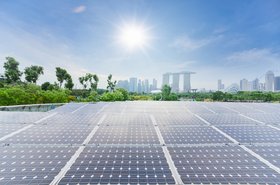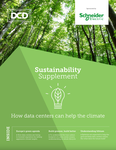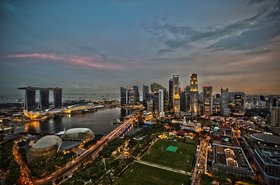For many of us, online access has become ingrained in our daily lives. The pandemic has accelerated the move to a digital lifestyle of working, studying, connecting with loved ones and relaxing — and the “new normal” looks set to stay for the foreseeable future.
Our digital lifestyle has undoubtedly resulted in higher Internet traffic and shifted the demand dynamics for data centers. Just consider the volume of video calls, streaming services and multiple messaging applications in use during a day when working from home. It’s no wonder that some 1.7MB of data was created every second by every person during 2020, and that a whopping 90 percent of the world’s data was created in the last two years alone.
Have we considered the energy needed to capture and manage the deluge of data we’re generating and consuming in our business dealings and private lives?
Energy-guzzling facilities
As the backbone of the Internet, data centers store, move, process and analyze the data needed to power any online service. A data center is also an energy-guzzling facility: with nearly 40 percent of energy going to its cooling systems to maintain a temperature-controlled environment, round the clock. Estimates further suggest that data centers account for up to 5 percent of global greenhouse gas emissions.
Just as your laptop heats up with heavy usage, server racks housing computing equipment in a data center emit heat when handling more data, thereby needing an efficient cooling solution. A fully efficient data center is one that requires one kilowatt of energy to cool the servers for every kilowatt of power used by these servers. That is not possible in reality due to the inevitable energy wastage and non-computing electrical installations including air-conditioning and lightings.
Against this backdrop, can data centers be carbon neutral, or even net carbon negative? Are green data centers a paradoxical concept?
Strategies to optimize energy
Data center operators are working to drive down energy consumption to advance sustainability in their facilities and decrease costs. One way is to invest in energy-efficient commercial chiller equipment that offers competitive energy performance and proven reliability. Smart buildings technology providers offer advanced chiller equipment, which uses low-global warming potential refrigerant and is optimized to reduce average annual electricity consumption by 35 percent. To push the envelope further, data center providers could even consider harnessing free-cooling chiller solutions, which include evaporative cooling technologies for even better energy efficiency.
Using digital resources and analytics is another way to optimize energy usage. In a typical data center, the servers’ load will vary throughout the day. A smart solution to monitor the energy consumption patterns allows data center managers to configure the optimal use of their resources, as well as to identify and diagnose equipment problems and take proactive steps to fix them. In some cases, smart chillers can reduce unplanned and emergency repairs by as much as 66 percent.
It’s also time to challenge the convention of operating data centers at low temperatures of 20 to 22°C. Evidence supports the running of data centers hotter than they currently are (by 1 or 2 degrees C) without any significant sacrifices in system reliability — and reap up to 5 percent savings in power consumption for chillers. Even Singapore’s IDA has conducted a tropical data center trial in which environmental temperatures were tested to a high of 38°C and ambient humidity at 90 percent or more.
Sustainable energy sources should be considered to power data centers, wherever possible. Singapore, for instance, has announced plans to quadruple its solar deployment by 2025, and working towards deploying at least 2 gigawatt-peak (GWp) of solar, which is about 3 percent of the country’s total projected energy consumption, by 2030.
The road ahead
Singapore has a tricky job to balance being an international hub while juggling to have data centers with low emissions. The local data center industry is expected to experience robust growth, but most of the facilities were designed and constructed without sustainability and energy conservation in mind. In fact, data centers account for 7 percent of the country’s total energy consumption, and could potentially increase to 12 percent by 2030.
The government has taken steps to incentivize and promote sustainable data centers in the nation, but more can be done. The whole process of developing data centers needs to be reconsidered — starting with power usage and efficiency needs at the design stage, and not towards the completion of the build, or when it’s time to retrofit the building.
What type of data centers do we want to see being built in Singapore? Data center builders and owners have to face a tough question: Will they be part of the solution, or will they exacerbate the problem?
Sustainability concerns, coupled with advances in cooling and heat management technology, have shifted the way data centers are being designed, managed and maintained. We’re seeing some headway in that direction — and that should be the way forward. Otherwise, we’ll be sacrificing our future to fulfill our insatiable need for data consumption and connectivity.





